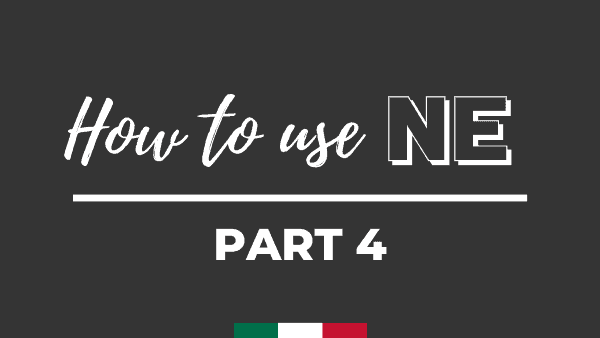Gender and Number in Passato Prossimo
Ellie asks: ” When does the PAST PARTICIPLE agree with the direct object in the PASSATO PROSSIMO?“
First things first…
The Italian Passato Prossimo looks just like the English Present Perfect (I have worked, I have seen, I have gone), but it translates both the English Simple Past (I worked, I saw, I went) and the English Present Perfect.
Since it “looks” and works almost like the English Present Perfect, we have to understand that there are always TWO components to an Italian Passato Prossimo:
- an auxiliary verb
- a past participle
Download the PDF
No email required
The same thing happens in English:
- the auxiliary verb is always the verb TO HAVE
- the past participle is created by added -ED to the verb (work-ed, ponder-ed, paint-ed), unless it's irregular (seen, done, drunken, eaten)
In Italian there are TWO possible auxiliary verbs:
- ESSERE (to be)
- AVERE (to have)
We use AVERE for all transitive verbs (verbs that need an object to make sense – “to paint”… you gotta paint something, right? – “to love”… you gotta love something or somebody, right? – “to speak”… you gotta speak words, right?).
We use ESSERE for all intransitive verbs (verbs that do not take an object and the action refers back to the subject – “to die”… you can't “die somebody”, right? – “to go”… it's about you going, you are moving yourself, not another person).
The Italian way to create a Past Participle is by:
-
removing the -ARE, -ERE or -IRE ending from the infinitive
-
Attaching one of the following endings:
– ATO (for -ARE verbs)
– UTO (for -ERE verbs)
– ITO (for -IRE verbs)
For example:
PARLARE -> PARLATO
CREDERE -> CREDUTO
FINIRE -> FINITO
Please note that we CANNOT use these past participles on their own to speak in the past. We always need an auxiliary verb before them!
HO PARLATO (I have spoken / I spoke)
ABBIAMO FINITO (we have finished / we finished)
So, when is there AGREEMENT?
First of all, by “agreement” of the Past Particle we mean this:
IERI MARIA È ANDATA A ROMA
Yesterday Maria went to Rome
You see what happened? The Past Participle of ANDARE, which is ANDATO, changed to a feminine!!!!
STAMATTINA CI SIAMO SVEGLIATI TARDI
This morning we woke up late
And now the Past Participle of SVEGLIARSI (to wake up), SVEGLIATO, has changed to a plural!!
Learn Italian to Fluency
- The program you've been dreaming of is here
- Better than having a private tutor
- In-Depth Italian lessons for complete clarity
- Extensive pratice opportunities
- Access to our community - you are never alone!
- A true learning experience to Italian Fluency
And here are the rules!
1) when the auxiliary verb is ESSERE there is AGREEMENT
2) when the auxiliary verb is AVERE there is NO AGREEMENT
3) when the auxiliary verb is AVERE and we use a direct object pronoun before the verb, there is AGREEMENT
First case: ESSERE
When the auxiliary verb is ESSERE there is AGREEMENT
Any time we are using a verb in the passato prossimo and this verbs uses ESSERE as the auxiliary, then the Past Particle will have all 4 options (same as an adjective):
- masculine singular
- feminine singular
- masculine plural
- feminine plural
For example:
IO SONO ANDATO (singular masculine subject)
I went
IO SONO ANDATA (singular feminine subject)
I went
NOI SIAMO ANDATI (plural masculine subject)
We went
NOI SIAMO ANDATE (plural feminine subject)
We went
SONO USCITO (I, male, went out)
SEI USCITA (You, female, went out)
L'AEREO È PARTITO (the airplane left)
LA MACCHINA È PARTITA (the car left)
ALL REFLEXIVE VERBS USE ESSERE AS THE AUXILIARY VERB
For example, the verb SVEGLIARSI (to wake up) in the passato prossimo would look like this:
MI SONO SVEGLIATO (singular masculine subject)
I woke up
MI SONO SVEGLIATA (singular feminine subject)
I woke up
CI SIAMO SVEGLIATI (plural masculine subject)
We woke up
CI SIAMO SVEGLIATE (plural feminine subject)
We woke up
The verb VEDERSI (to see each other) would go:
CI SIAMO VISTI to mean “we saw each other”.
Second case: AVERE
When the auxiliary verb is AVERE there is NO AGREEMENT
When the verb we want to express in the past uses AVERE as the auxiliary we do not worry about changing the past participle. No matter who/what the subject or the object is.
LUI HA MANGIATO LA PIZZA
He ate (the) pizza
LEI HA MANGIATO LA PIZZA
She ate (the) pizza
DANIELE E MARCO HANNO MANGIATO IL PANE
They ate (the) bread
SANDRA E GINA HANNO MANGIATO IL PANE
They ate (the) bread
As you can see MANGIATO did NOT change to MANGIATA or MANGIATI or MANGIATE. Nope.
NOI ABBIAMO VISTO ENRICO
We saw Enrico (a man)
NOI ABBIAMO VISTO MARTA
We saw Marta (a woman)
join our italian community
- Access a ton of content on this website
- Weekly Digest with a ton of Italian lessons, videos & facts!
- Invitation to Live Q&A Lessons with Manu
- Invitation to exclusive Webinars, Live Lessons & Games
- Coupons, Discounts & Specials for our Premium Italian Courses
Third case: AVERE with pronouns
When the auxiliary verb is AVERE and we use a direct object pronoun before the verb, there is AGREEMENT
When we speak in the Passato Prossimo and the verb uses AVERE as the auxiliary AND we use a Direct Object Pronoun before the verb (which is were object pronouns go in Italian!) THERE IS AGREEMENT between the Past Particle and the Object of the verb.
That's because we put the object BEFORE the verb, so this creates the expectation of GENDER and NUMBER.
IO TI HO VISTO
I saw you – “you” is a man
IO TI HO VISTA
I saw you – “you” is a woman
TU L'HAI MANGIATO
You ate it – “it” is a masculine object
TU L'HAI MANGIATA
You ate it – “it” is a feminine object
TU LI HAI MANGIATI
You ate them – “them” is a masculine object plural
TU LE HAI MANGIATE
You ate them – “them” is a feminine object plural
| The direct Object Pronouns are… | And they translate the English direct objects: |
| MI | ME |
| TI | YOU |
| LO / LA | IT / HIM /HER |
| CI | US |
| VI | YOU plural |
| LI / LE | THEM |
▷ SOME EXAMPLES:
If we've been talking about eating a sandwich, and then we just want to use a pronoun to refer to it (“it” in English), this would happen:
HO MANGIATO IL PANINO
IL PANINO: would be replaced with the pronoun LO (masculine singular)
Then we'd say:
LO HO MANGIATO
(it I have eaten)
In reality we'll say:
L'HO MANGIATO
HO MANGIATO LA MELA
LA MELA: would be replaced with the pronoun LA (feminine singular)
Then we'd say:
LA HO MANGIATA
(it I have eaten)
In reality we'll say:
L'HO MANGIATA
HO MANGIATO I PANINI
I PANINI: would be replaced with the pronoun LI (masculine plural)
Then we'd say:
LI HO MANGIATI
(them I have eaten)
We never abbreviate the plural pronouns.
HO MANGIATO LE MELE
LE MELE: would be replaced with the pronoun LE (feminine plural)
Then we'd say:
LE HO MANGIATE
(them I have eaten)
Download the PDF
No email required



